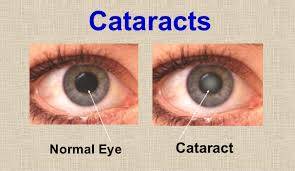Cataract is a medical condition that affects the eye's natural lens, causing it to become cloudy or opaque. This clouding of the lens can lead to vision problems. Here's more information:
**Definition:**
Cataract is a progressive condition where the eye's clear lens becomes cloudy, causing blurred or impaired vision.
**Ten Common Causes of Cataracts:**
1. Aging: The most common cause, as the lens naturally becomes less transparent over time.
2. UV Radiation: Prolonged exposure to sunlight can increase the risk.
3. Smoking: Smoking is a risk factor for cataracts.
4. Diabetes: High blood sugar levels can contribute to cataract formation.
5. Trauma: Eye injuries can lead to cataracts.
6. Medications: Some medications, like corticosteroids, may increase the risk.
7. Genetics: Family history can play a role.
8. Obesity: Being overweight may increase the likelihood of cataracts.
9. Alcohol Consumption: Excessive alcohol intake can be a risk factor.
10. Other Medical Conditions: Hypertension and eye conditions can contribute.
**Effects of Cataracts:**
1. Blurred Vision: Vision becomes progressively blurred.
2. Glare Sensitivity: Difficulty with bright lights or glare.
3. Reduced Night Vision: Trouble seeing in low-light conditions.
4. Color Distortion: Colors may appear faded or yellowish.
5. Double Vision: Seeing double images in one eye.
6. Difficulty Reading: Trouble reading small print.
7. Decreased Independence: Impaired vision affects daily activities.
8. Falls and Accidents: Increased risk of accidents due to poor vision.
9. Depression: Vision loss can lead to emotional distress.
10. Legal Blindness: In severe cases, cataracts can lead to legal blindness.
**Ways of Solving Cataracts:**
1. **Cataract Surgery:** The most common and effective solution is surgical removal of the cloudy lens and its replacement with an artificial intraocular lens (IOL).
2. **Lifestyle Changes:** Reducing risk factors like smoking, excessive alcohol consumption, and maintaining a healthy weight can help prevent cataracts.
3. **Protective Eyewear:** Wearing sunglasses with UV protection can reduce the risk of cataracts caused by UV radiation.
4. **Regular Eye Exams:** Routine eye check-ups can help detect cataracts early, allowing for timely intervention.
5. **Manage Underlying Conditions:** Properly managing conditions like diabetes and hypertension can reduce the risk of cataracts.
6. **Medication Review:** Consult with a healthcare provider to evaluate the necessity of medications that may contribute to cataracts.
If you suspect you have cataracts or are experiencing vision problems, it's crucial to consult an eye specialist for an accurate diagnosis and appropriate treatment options.


